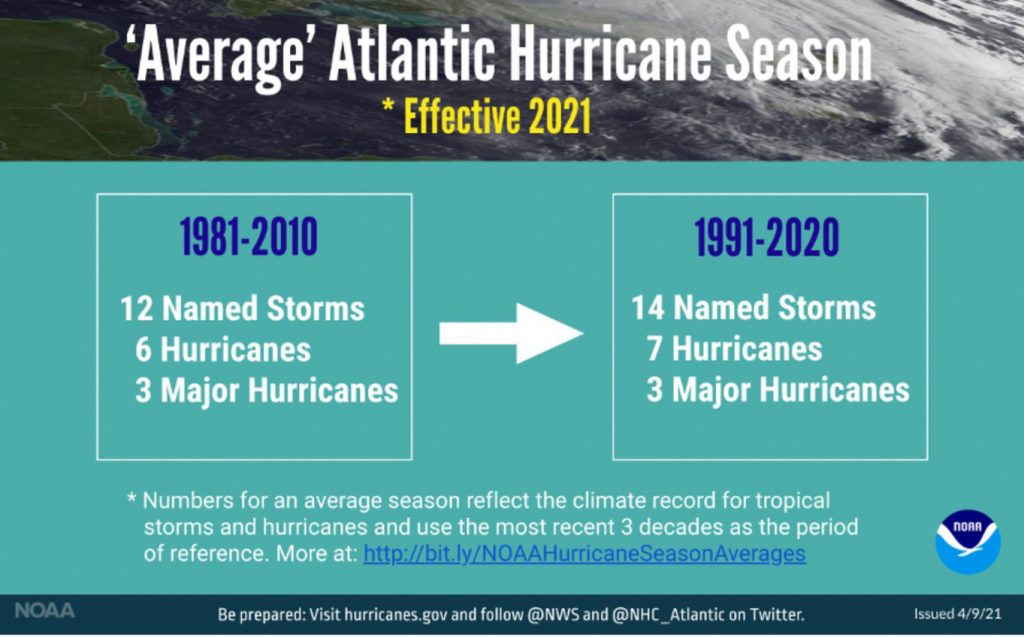As of June 1, hurricane season is upon us. Almost without exception, we in the Northeast USA get the tail, shoulder or rump of one or two of the dozen or so that form up in the Atlantic between the Caribbean and Africa and bring so much destruction and misery with them as they thunder west and north…and now, an “average” season is worse than ever. This column is about that.
As the time of this writing (mid-May), the National Oceanic and Atmospheric Administration (NOAA) was preparing to issue its initial 2021 hurricane season outlook.
As you can see from the table, this year’s NOAA prediction will use new numbers for an “average” season: fourteen named storms, up from twelve, and seven hurricanes, up from six, including three major hurricanes (Category 3, 4 or 5). The NOAA’s definition of “average” has increased because it’s now using a 30-year period of record, from 1991 to 2020. The previous 30-year period used storms from 1981 to 2010.

Courtesy: NOAA
“Major hurricanes” are defined as Category 3, 4 or 5 based on the Saffir-Simpson Hurricane Wind Scale (see table below). Hurricanes that fall in these categories have sustained winds above 111 miles per hour, which can cause catastrophic damage that could result in power outages and leave residential areas uninhabitable for several days to months.
Categories of Hurricanes
We’ve all heard the weather reporter state that “Hurricane ‘X’ is now a Category 3 hurricane and headed for ________.” What does that mean?
USCG hurricane aircraft reported Andrew, Katrina and Dorian had generated winds over 200mph at various times.
When looking at Category 5s, no one is saying that there is no difference between a storm that brings 160-mile-per-hour winds and one that reaches 190. The force of the winds goes up with the square of the velocity. In layman’s terms, that means a hurricane with 200-mile-per-hour winds has four times — not just double — the force of one with 100-mile-per-hour winds.
NOAA updates the statistics it uses for its prediction models once a decade. “This update allows our meteorologists to make forecasts for the hurricane season with the most relevant climate statistics taken into consideration,” said Michael Farrar, director of NOAA’s National Centers for Environmental Prediction, in a statement.
The official hurricane season runs from June 1 through November 30, but storms can form before and after. We’ll write more about this in the weeks ahead.
If you are interested in being part of USCG Forces, email me at JoinUSCGAux@aol.com or go direct to the D1SR Human Resources department, who are in charge of new members matters, at DSO-HR and we will help you “get in this thing…” ■
The Captain of the Port and Sector Commander for U.S. Coast Guard Sector Long Island Sound is Captain Eva Van Camp Schang. CAPT Van Camp Schang is responsible for all active-duty, reservist and auxiliary Coast Guard personnel within the Sector. As a Commodore in the U.S. Coast Guard Auxiliary First District, Southern Region, Vin Pica works closely with CAPT Van Camp Schang and her staff to promote boating safety in the waters between Connecticut, Long Island and 200 nautical miles offshore. Sector Long Island Sound Command Center can be reached 24 hours a day at 203-468-4401.
Editor’s note: Weekly updates for the waters from Eastport, ME to Shrewsbury, NJ including discrepancies in Aids to Navigation, chart corrections and waterway projects are listed in the USCG Local Notice to Mariners. Log onto navcen.uscg.gov, scroll to “Current Operational/Safety Information,” click on “Local Notice to Mariners” then “LNMs by CG District,” and click on “First District.”



